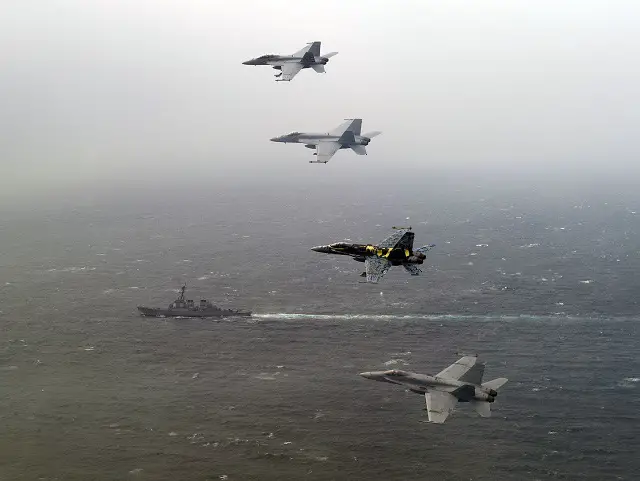 ARABIAN
GULF (Feb. 25, 2012) From top; an F/A-18F Super Hornet assigned to Strike
Fighter Squadron (VFA) 22, flown by Lt. Cmdr. Warren Tomlinson and Lt.
j.g. Josh Raymond, an F/A-18E Super Hornet assigned to Strike Fighter
Squadron (VFA) 81 flown by Lt. Daniel Solfelt, an F/A-18C Hornet assigned
to Strike Fighter Squadron (VFA) 113, flown by Cmdr. Craig Sicola, and
an F/A-18C Hornet assigned to Strike Fighter Squadron (VFA) 25 flown
by Lt. Taylor Hesse, fly over the Arleigh Burke-class guided missile
destroyer USS John Paul Jones during a mission flown from the Nimitz-class
aircraft carrier USS Carl Vinson (CVN 70). Carl Vinson and CVW 17 are
deployed to the U.S. 5th Fleet area of responsibility. (U.S. Navy photo
by Mass Communication Specialist 2nd Class James R. Evans/Released)
ARABIAN
GULF (Feb. 25, 2012) From top; an F/A-18F Super Hornet assigned to Strike
Fighter Squadron (VFA) 22, flown by Lt. Cmdr. Warren Tomlinson and Lt.
j.g. Josh Raymond, an F/A-18E Super Hornet assigned to Strike Fighter
Squadron (VFA) 81 flown by Lt. Daniel Solfelt, an F/A-18C Hornet assigned
to Strike Fighter Squadron (VFA) 113, flown by Cmdr. Craig Sicola, and
an F/A-18C Hornet assigned to Strike Fighter Squadron (VFA) 25 flown
by Lt. Taylor Hesse, fly over the Arleigh Burke-class guided missile
destroyer USS John Paul Jones during a mission flown from the Nimitz-class
aircraft carrier USS Carl Vinson (CVN 70). Carl Vinson and CVW 17 are
deployed to the U.S. 5th Fleet area of responsibility. (U.S. Navy photo
by Mass Communication Specialist 2nd Class James R. Evans/Released)
|
"We
put our latest AESA radar capability to the test and it exceeded our
expectations," said Mike "Ponch" Garcia, business development
director of Tactical Airborne Systems for Raytheon's Space and Airborne
Systems business, and a former F/A-18E/F Super Hornet pilot/instructor.
"Our APG-79(V)X combines the best features of our AESA portfolio
to ensure low risk and give F/A-18C/D a tactical advantage for the next
15 to 20 years."
The company has delivered more than 500 tactical AESA tactical radars
from its portfolio that includes the APG-79, APG-63(V)3 and APG-82(V)1
for F-15, F/A-18E/F, EA-18G and B-2 aircraft. The APG-79 system, a U.S.
Navy program of record, flies globally on F/A-18E/F Super Hornets and
EA-18G Growlers, and has seen service in four combat theaters since
its first delivery in 2006.
"Raytheon fielded the world's first operational AESA radar for
fighter aircraft in 2000," said Roy Azevedo, vice president for
Raytheon's Space and Airborne Systems business. "Our portfolio
of tactical AESA radars has now flown more than 500,000 operational
hours – an industry first. We will continue to advance this technology
to give our warfighters the greatest possible tactical advantage." |